Growing ghost peppers, one of the hottest chilies in the world, can be a thrilling venture for spice enthusiasts and gardeners alike. When planting ghost pepper seeds, it’s important to provide them with the right conditions to thrive. These peppers flourish in warm climates with plenty of sunlight, so make sure to plant them in an area that receives full sun for at least 6-8 hours per day. The soil should be well-draining and rich in organic matter, which will help the plants stay healthy and stress-free throughout their growing season.
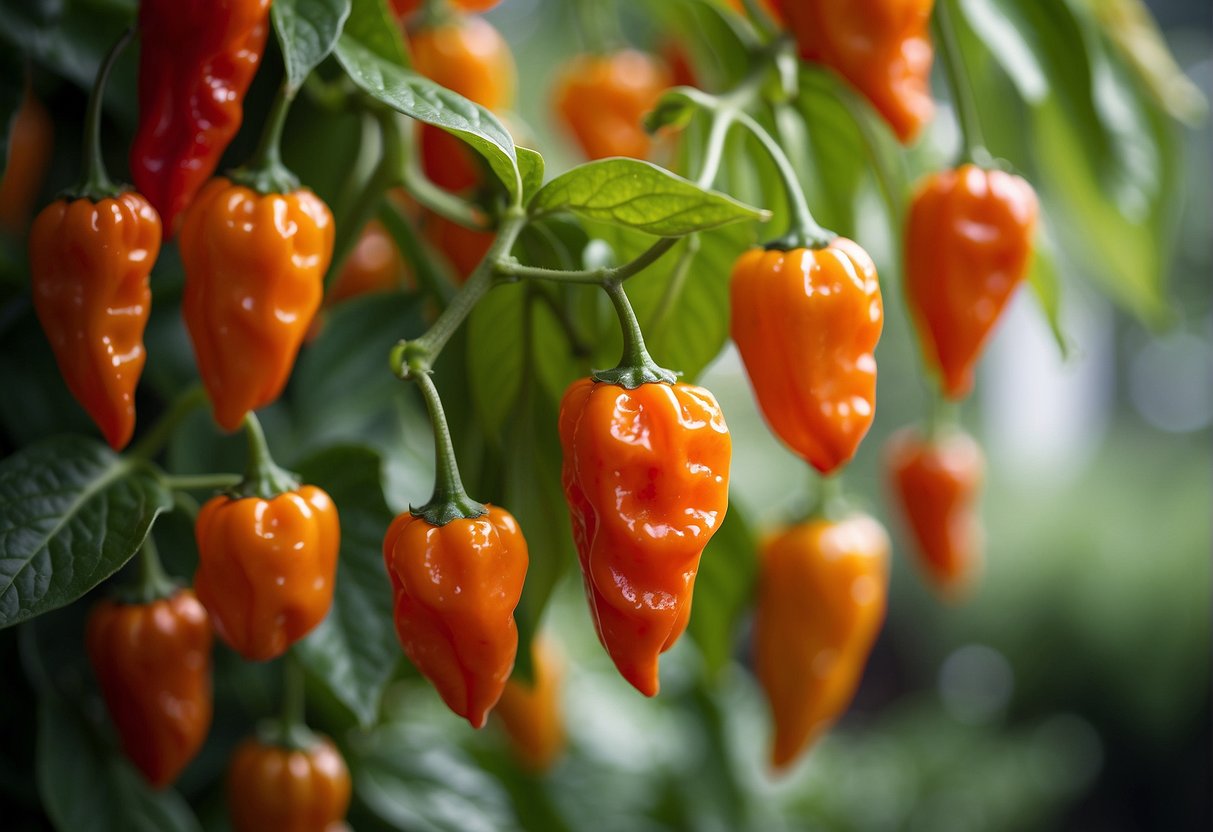
As your ghost pepper plants mature, keeping an eye on the fruit’s development is key to harvesting them at their peak ripeness. A ripe ghost pepper typically transitions in color from green to a bright red, indicating it’s ready to be picked. This color change usually occurs about 100 days after transplanting, depending on the growing conditions. It’s crucial to wait for this color shift, as the full heat and flavor of the peppers develop only when they are fully ripe.
Identifying Ripeness
When you’re looking to harvest ghost peppers, there are several indicators to assess their ripeness accurately.
Color Change
Initially, your ghost peppers will be a vibrant green, indicating they’re unripe. As they mature, watch for a progressive change to yellow, then orange, and finally a deep red when they’re fully ripe. This color transition is a key signal that it’s nearly time to harvest.
Texture and Firmness
A ripe ghost pepper should have a slightly soft texture when gently squeezed. However, it should not feel mushy. If it’s unripe, the pod will be firm. Be observant for any wrinkles, as a mature ghost pepper may have slight wrinkling but shouldn’t be excessively wrinkled.
Size and Shape
Ghost peppers reach their optimal size and shape just before ripening. They will typically be 2.5 to 3.5 inches in length. Once they achieve this size, they may still be green, but they are approaching maturity.
Stem and Attachment
The stem should be healthy and show no signs of decay. If the stem begins to crack near the point of attachment, or it becomes easier to pull the pod from the plant, these are signs that the pepper is ripe or very close to ripeness.
Overall Plant Maturity
Keep in mind the whole plant’s maturity. Ghost peppers generally need between 90 and 150 days from planting to reach full maturity. If it’s towards the end of the growing season and the plants have had adequate time to develop, it’s more likely that any sizeable peppers you see are ripe or nearly ripe.
Harvesting Techniques
https://www.youtube.com/watch?v=dAQAZOJxVIE&embed=true
When it’s time to harvest your ghost peppers, also known as bhut jolokia, there are some specific techniques you’ll need to follow to do it safely and effectively. Let’s guide you through the proper attire, the best time for harvesting, the tools you’ll need, and how to handle the peppers post-harvest.
Protective Wear
Before you begin the harvest, always wear gloves to protect your skin from irritation. Ghost peppers contain capsaicin, which can cause a burning sensation upon contact. It’s also wise to don long sleeves and eye protection, just in case.
Timing of Harvest
Timing is critical. Pick your ghost peppers when they’re a vibrant red and have a slight give when gently squeezed. This typically occurs 90 to 150 days after planting. Harvesting too early can result in a lackluster flavor, while waiting too long may cause them to rot on the vine.
Using Tools
Use a pair of sharp pruning shears or scissors to cut the peppers from the plant. Make a clean cut through the stem about an inch from the pepper to avoid damaging the plant and the fruit. It helps to avoid pulling or twisting as this can harm both the pepper and the vine.
Handling After Harvest
Once harvested, handle your ghost peppers with care. Place them gently into a basket or container to prevent bruising. For storage, keep them in a cool, dry place if you’re not using them immediately. Remember that proper handling is essential, whether for immediate cooking or long-term storage.
Growing Conditions and Care
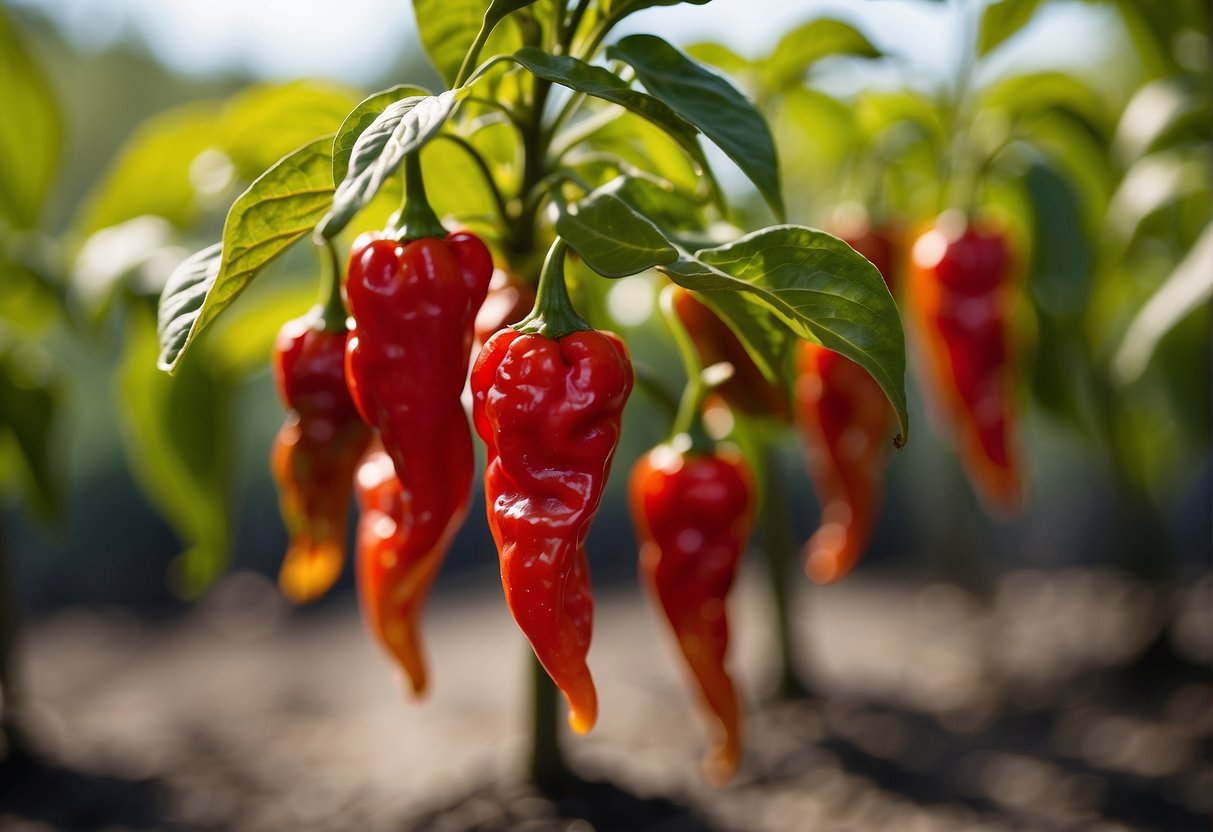
To ensure your ghost pepper plants thrive, focus on providing an optimal environment through proper climate conditions, soil management, and care in watering and pruning. It’s also crucial to diligently prevent pests and disease for a healthy harvest.
Optimal Climate and Temperature
Ghost pepper plants need a warm and humid climate to flourish. They thrive in temperatures between 75°F and 90°F. Ensure your plants receive at least 6 to 8 hours of direct sunlight daily, and consider using a greenhouse or row covers if you’re in a cooler region.
Soil and Fertilization
For the best growth, plant your ghost peppers in well-draining soil with a pH between 6.0 and 6.8. Soil enrichment is best achieved by applying a balanced, slow-release fertilizer with equal parts nitrogen, phosphorus, and potassium at the beginning of the growing season and supplementing with a phosphorus-heavy fertilizer during the fruiting stage.
Watering and Pruning Practices
Regular and consistent watering is key, but be careful not to over-water. Aim for moist soil that’s not soggy. As for pruning, it helps to increase yield and air circulation; snip off any lower branches that don’t receive sunlight or show signs of disease or damage.
Preventing Pests and Disease
Stay vigilant in inspecting your plants for signs of pests or disease. Use organic pesticides when necessary, and remove any diseased leaves promptly to prevent spread. Adequate spacing between plants and crop rotation can also minimize the risk of disease.
Utilization and Culinary Applications
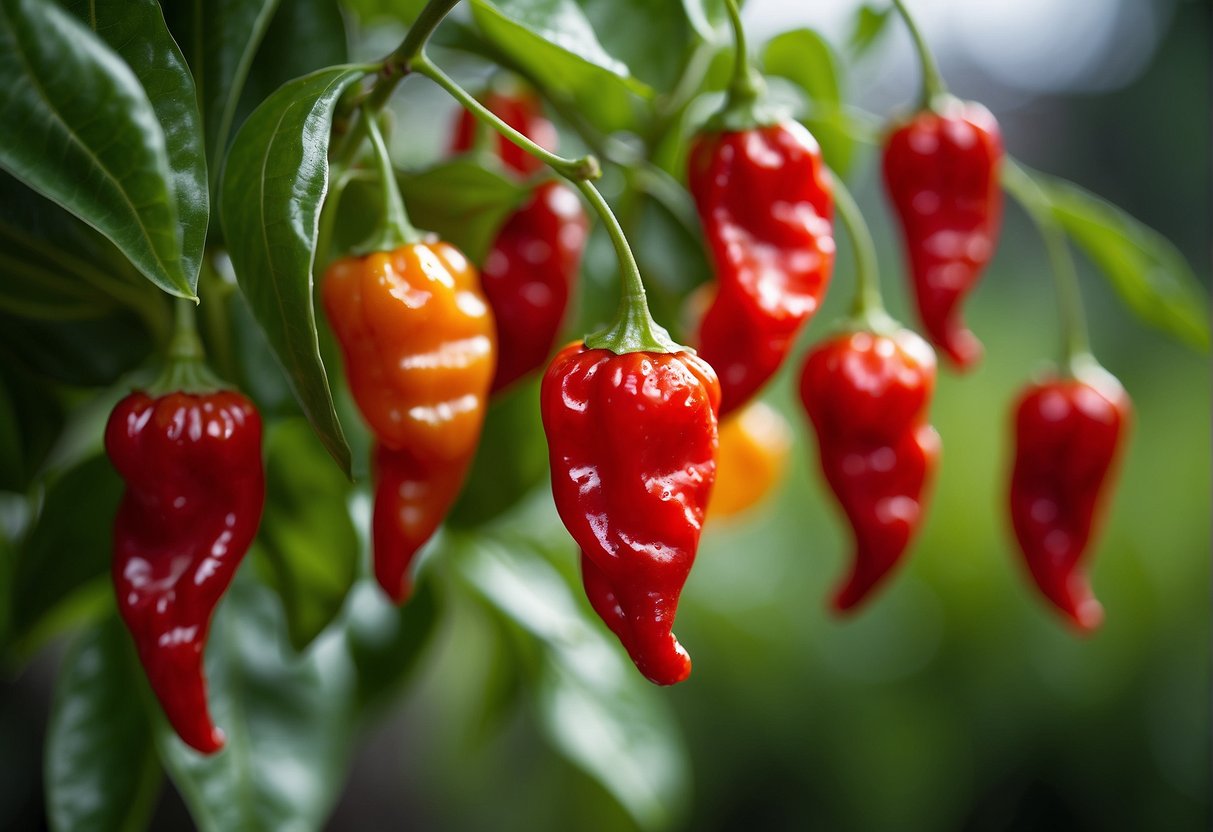
When you’re ready to take your culinary game to the next level with ghost peppers, remember they rank among the hottest peppers on the Scoville scale, so handle them with care. Their intense heat can transform dishes, but you’ll want to ensure you’re prepared for the experience.
Cooking with Ghost Peppers
When cooking with ghost peppers, also known as Bhut Jolokia, a little goes a long way due to their extreme spiciness, measured at over 1 million Scoville heat units. Incorporate them into your dishes sparingly to add a distinctive flavor and capsaicin-induced heat. They’re commonly used in hot sauces and marinades or as a spice in small quantities. Remember to wear gloves and avoid touching your face or eyes during preparation.
- Hot Sauces: Blend ghost peppers with vinegar and other spices.
- Marinades: Mince a small piece for a spicy kick.
- Dishes: Add a hint to curries or stews for depth and spice.
Storage and Preservation
Proper storage is crucial for maintaining the flavor and spiciness of ghost peppers. To keep them fresh, store at room temperature for a few days or in the refrigerator for up to a week. For longer preservation, you can dry or pickle them.
- Drying: Hang them in a well-ventilated area until brittle.
- Pickling: Submerge in vinegar along with spices for a tangy preserve.
Ghost Pepper Varieties in Cuisine
Different types of ghost peppers, such as the Chocolate or Peach Ghost Pepper, can be used in various dishes. The Peach variety has a slightly fruity undertone, making it suitable for sauces and salsas, while the Chocolate version offers a smokier flavor to your recipes.
- Peach Ghost Pepper: Sauces, salsas, chutneys.
- Chocolate Ghost Pepper: Smoky marinades, barbeque sauces.
Preparing for the Heat
Before adding ghost peppers to your cooking, it’s essential to prepare for their heat level. Ensure that you have dairy products like milk or yogurt on hand to counteract the burn if needed. Start with a tiny amount, since ghost peppers are significantly hotter than common spicy peppers. Building tolerance gradually can enhance your enjoyment of their rich flavor while keeping the spiciness manageable.
- Dairy Products: Keep milk or yogurt ready to soothe the spiciness.
- Tolerance: Begin with minimal amounts to build up heat endurance.
Health and Safety Considerations
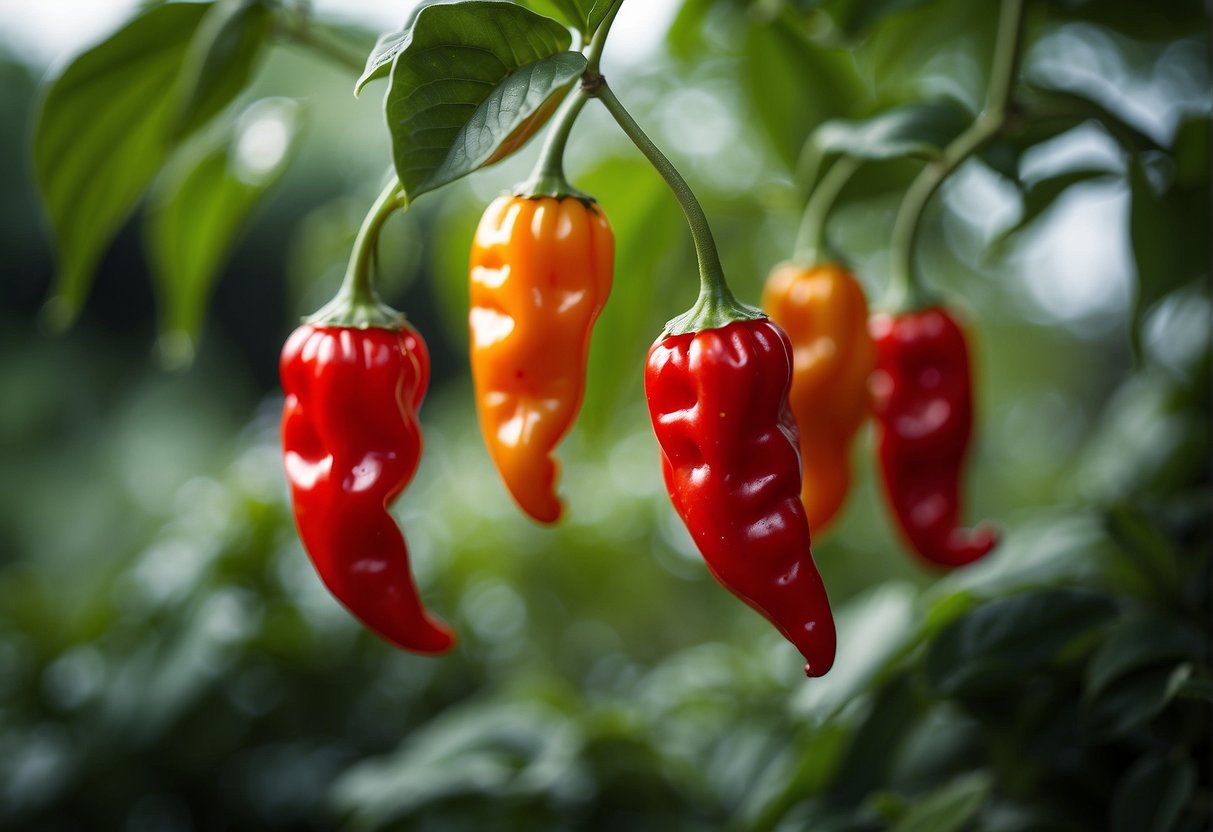
When you’re working with ghost peppers, safety is paramount. You’ll want to protect your skin and eyes from irritation, manage the heat intensity of the peppers, and know how to respond in case of exposure.
Protective Measures When Handling
When dealing with ghost peppers, always wear gloves to prevent skin irritation. The capsaicin in these peppers, which gives them their intense heat, can cause a significant burning sensation on unprotected skin. It’s also a good idea to wear long sleeves and use eye protection to safeguard against accidental rubbing or splashes that can irritate your eyes.
- Do:
- Use nitrile or latex gloves
- Wear long sleeves
- Protect your eyes with goggles
- Don’t:
- Handle peppers with bare hands
- Touch your face or eyes while handling peppers
Recognizing and Managing Heat Intensity
Ghost peppers are extremely spicy and rank very high on the Scoville scale, which measures the heat level of peppers. The Scoville heat units (SHU) for a ghost pepper can exceed 1 million, signifying extreme spiciness. Understanding this, you should be cautious with how many peppers you handle at once and the duration of handling—to limit exposure to the heat.
- Ghost Pepper Heat Level:
- Scoville scale: Often >1 million SHU
- Tips:
- Work in a well-ventilated area
- Limit the number of peppers you handle at once
First Aid for Pepper Burns
If you come into contact with ghost pepper and experience a burn:
- Remove gloves immediately to avoid spreading capsaicin.
- Wash affected skin with soap and water.
- Use milk or yogurt to relieve the burning sensation, as the dairy helps to break down capsaicin.
- In case of eye exposure, rinse your eyes with cool water for at least 15 minutes.
- If you ingest a pepper and feel discomfort, drink milk or eat rice to dilute the heat.
- For Skin:
- Soap and water
- Milk or yogurt application
- For Eyes:
- Flush with cool water
- If Ingested:
- Drink milk or eat rice
Frequently Asked Questions
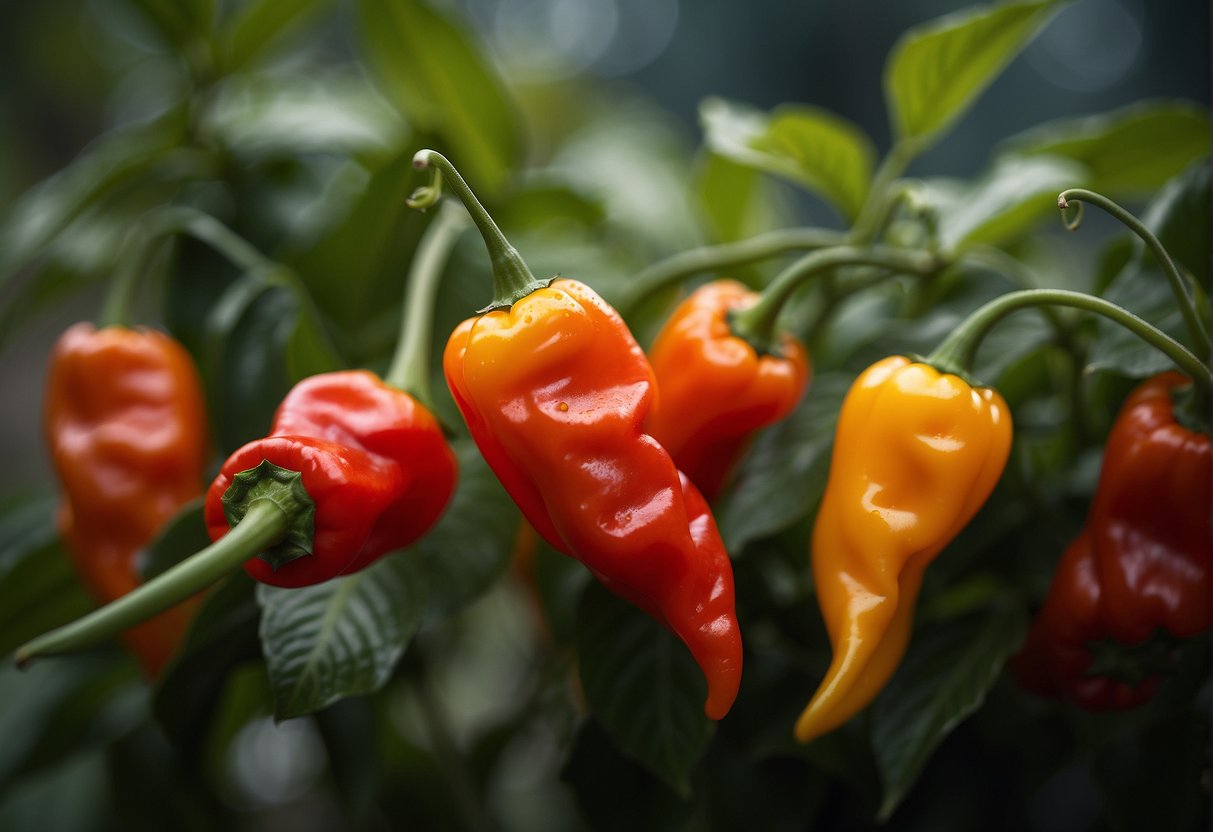
In this section, you’ll find specific answers to common queries about identifying when ghost peppers are ripe, gauging their heat, and preserving their freshness.
What are the indicators that a ghost pepper is fully mature and ready to harvest?
When a ghost pepper is mature, it typically has a firm texture and changes color from green to a vibrant red or orange. The skin may also become slightly wrinkled, and the pepper should easily come off the stem with a gentle tug.
Can the level of heat in a ghost pepper change depending on its ripeness?
Yes, the heat level of a ghost pepper can increase as it ripens. A fully matured ghost pepper has a higher concentration of capsaicin, which is responsible for the spicy heat, compared to one that is not entirely ripe.
How can I best preserve the freshness of my ghost peppers after picking them?
To preserve their freshness, store ghost peppers in a dry, well-ventilated area. For longer preservation, you can also freeze them whole or dry them out.
Do ghost peppers continue to ripen after being removed from the plant, and if so, how do you accomplish this?
Ghost peppers can continue to ripen off the plant if they are picked when they start showing their mature color. Keep them at room temperature in a spot with good airflow away from direct sunlight to encourage ripening.
What variety of colors can ghost peppers exhibit when they reach full ripeness?
Ghost peppers can display a range of colors when ripe, including red, orange, or even chocolate brown. The color depends on the specific variety of the ghost pepper plant grown.
When cultivating ghost peppers, what is the usual time frame for them to mature?
Ghost peppers typically take 90 to 150 days to mature after planting. This can vary depending on growing conditions and the specific cultivar. It is important to monitor the plants closely as they near the expected maturity date.
